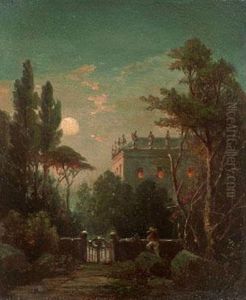Theodor Rehbenitz Paintings
Theodor Rehbenitz was a notable German artist born in the late 18th century, specifically in 1791, in the city of Stralsund, which was then part of Swedish Pomerania but is now in Germany. His contributions to art, particularly within the realms of drawing and painting, reflect the broader movements of the Romantic period, yet his work also possesses unique qualities that distinguish him within the art historical canon. Rehbenitz's education and artistic development were significantly shaped by his time at the Academy of Fine Arts Vienna, where he was exposed to the leading artistic theories and practices of his time.
Rehbenitz's career was marked by his dedication to both the execution and teaching of art. His style evolved over time, initially influenced by the neoclassical ideals prevalent during his early education, but gradually incorporating more romantic and realist elements as he developed his own artistic voice. His oeuvre includes a wide range of subjects, from classical and mythological scenes to more contemporary landscapes and portraits, reflecting the versatility and breadth of his skillset.
In addition to his artistic pursuits, Theodor Rehbenitz was deeply involved in academic and educational roles, contributing to the development of the next generation of artists. His commitment to education was evident in his long-standing association with the Academy of Fine Arts in Munich, where he served as a professor. Here, he influenced many students, instilling in them the importance of both technical proficiency and creative expression.
Rehbenitz's work was well-regarded by his contemporaries, and he participated in numerous exhibitions throughout his career. Despite the recognition he received during his lifetime, his legacy has not been as prominent in the broader art historical narrative as some of his peers. The reasons for this relative obscurity are varied but include the shifting tastes of the art world and the dominance of other movements and personalities within the 19th-century art scene.
Theodor Rehbenitz died in 1861, leaving behind a body of work that, while perhaps not as widely recognized today, continues to offer valuable insights into the artistic and cultural milieu of 19th-century Germany. His contributions to German art, particularly in the realms of drawing and painting, remain subjects of interest for scholars and enthusiasts of the period.
